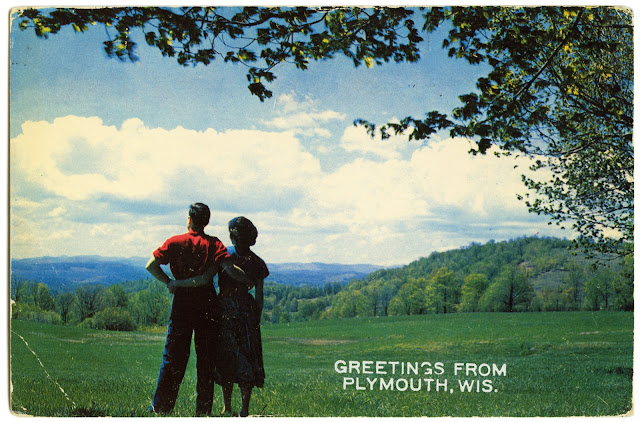 |
| Lakeview Motel in the Snow, Highway 55 at County F, Chilton, Wisconsin (12.14.2013) © J. Shimon & J. Lindeman |
Not far from Lake Winnebago, this mid-century motel on Highway 55 still operates
with a restaurant and deck to view sunsets.
 |
| Lakeview Motel in the Snow, Highway 55 at County F, Chilton, Wisconsin (12.14.2013) © J. Shimon & J. Lindeman |
 |
| Residence (Peace on Earth), Man-Cal Road near Wayside, Wisconsin (12.2.2013) |
 |
| Tinker Tot Drive-In, Highway 8 (Edgewood Avenue), Ladysmith, Wisconsin (7.11.2013) © J. Shimon & J. Lindeman |
 |
| Found: Indian Bowl, Lac du Flambeau, Wis. Made by Dexter, West Nyack, NY. Published by Wyman Post Card Co., Wausau, circa 1951 |
 |
| Found: "High Council Campfire" Boys' & Girls' Brigade. Camp Onaway, R.R. 6 - Box 2015, Waupaca, WI 54981. Photo of Don Weber by Rick Erdmann. Kolorvue Post Card Co., New York, circa 1970s-1980s. |
 |
| Found: Wisconsin Trecenenary (1634-1934) postage stamp |
 |
| Found: Landfall of Jean Nicolet in Wisconsin (1907) by Edward Willard Deming on view in the Wisconsin State Capitol in Madison |
 |
| 1949 Nash Ambassador Super Four-Door Sedan with 1800s Stone Shed, Polifka Corners, Whitelaw, Wisconsin, July 2013 © J. Shimon & J. Lindeman |
 | |
| Found: Lance Little Eagle, Native Winnebago Indian Wisconsin River Guide Autographed and dated 7/24/76 Photo by John A. Trumble Published by Dells Photo Service, Wisconsin Dells, Wisconsin Circa 1960s |
 |
| Found: The Gem Room, North Cave, Opened in 1946, Cave of the Mounds, Blue Mounds, Wisconsin. 25 Miles West of Madison, Wis. on Highway 18-151, Curteich, Chicago, C.T. Art-Colortone, circa 1940s |
 |
| Found: Vacation Paradise, Solon Springs, Wisconsin. Photographed and distributed © Gallagher's Studio, Duluth, Minnesota. Written on back in ballpoint: "We are enjoying the lake where my folks live - swimming, water skiing and drinking coffee...Pastor Swanson." Postmarked Solon Springs, July 5, 1962. Circa 1960s. |
 |
| Found: Luther Park Bible Camp, Chetek, Wisconsin. A warm day at Luther Park leads campers to the waterfront. What will it be? Water skiing, pontoon or canoe ride or a refreshing swim? What ever it is will be great fun as young Christians find adventure in Christ. Published by G. R. Brown Co., Rt. 5, Eau Claire, WI 54701. Made by Dexter Press, New York. Circa 1970s. |
 |
| Double Wedding (Drinking a Rhinelander Shorty), Wisconsin Concrete Park, Phillips, Wisconsin (7.11.2013) © J. Shimon & J. Lindeman |
 |
| Pointing to the Horse, Wisconsin Concrete Park, Phillips, Wisconsin (7.11.2013) © J. Shimon & J. Lindeman |
 |
| Budweiser Clydesdales Team (Fred Smith's last work), Wisconsin Concrete Park, Phillips, Wisconsin (7.11.2013) © J. Shimon & J. Lindeman |
 |
| Farming with Horses, Wisconsin Concrete Park, Phillips, Wisconsin, rephotographed (7.11.2013) © J. Shimon & J. Lindeman |
 |
| Found: Fred Smith's Concrete Museum (Farming with Horses), Phillips, Wis., circa 1950s |
 |
| Kerosene Wagon and Paul Bunyan, Wisconsin Concrete Park (without portrait of Fred Smith), Phillips, Wisconsin, rephotographed (7.11.2013) © J. Shimon & J. Lindeman |
 |
| Found: Fred Smith's Concrete Museum (with portrait of Fred Smith), Phillips, Wis., circa 1950s |
 |
| Found: Fred Smith's Concrete Museum, Phillips, Wis. (portrait of Fred Smith with Kerosene Wagon and Paul Bunyan statues), published by L. L. Cook Co., Milwaukee, WI, circa 1950s. |
 |
| Found: Fred Smith's Concrete Museum, Phillips, Wis. (farming with horses statues), published by L. L. Cook Co., Milwaukee, WI, circa 1950s. |
"An outdoor museum comprised of over 200 embellished concrete sculptures built by Fred Smith (1886-1976), a self-taught artists and retired lumberjack. Within this installation of monuments Smith created a cohesive panorama of history, legend, and his immense imagination. Conceived and created in his senior years, Smith built the Wisconsin Concrete Park as a gift "...for all the American people everywhere. They need something like this." (p. iii)
 |
| Found: Greeting From Plymouth, Wisconsin. Honeymoon in the Country by Ozzie Sweet. Published by Plastichrome, Boston circa 1960. |
 |
| House with Shutters, College Avenue, Appleton, Wisconsin, October 16, 2012 © J. Shimon & J. Lindemann |
